Effective Business Communication: Importance of Non-Verbal Communication Skills
VerifiedAdded on 2023/06/07
|8
|2058
|327
AI Summary
This article discusses the importance of non-verbal communication skills in effective business communication. It explains how it can be applied in future career aspirations. The article also provides a literature review on the topic.
Contribute Materials
Your contribution can guide someone’s learning journey. Share your
documents today.
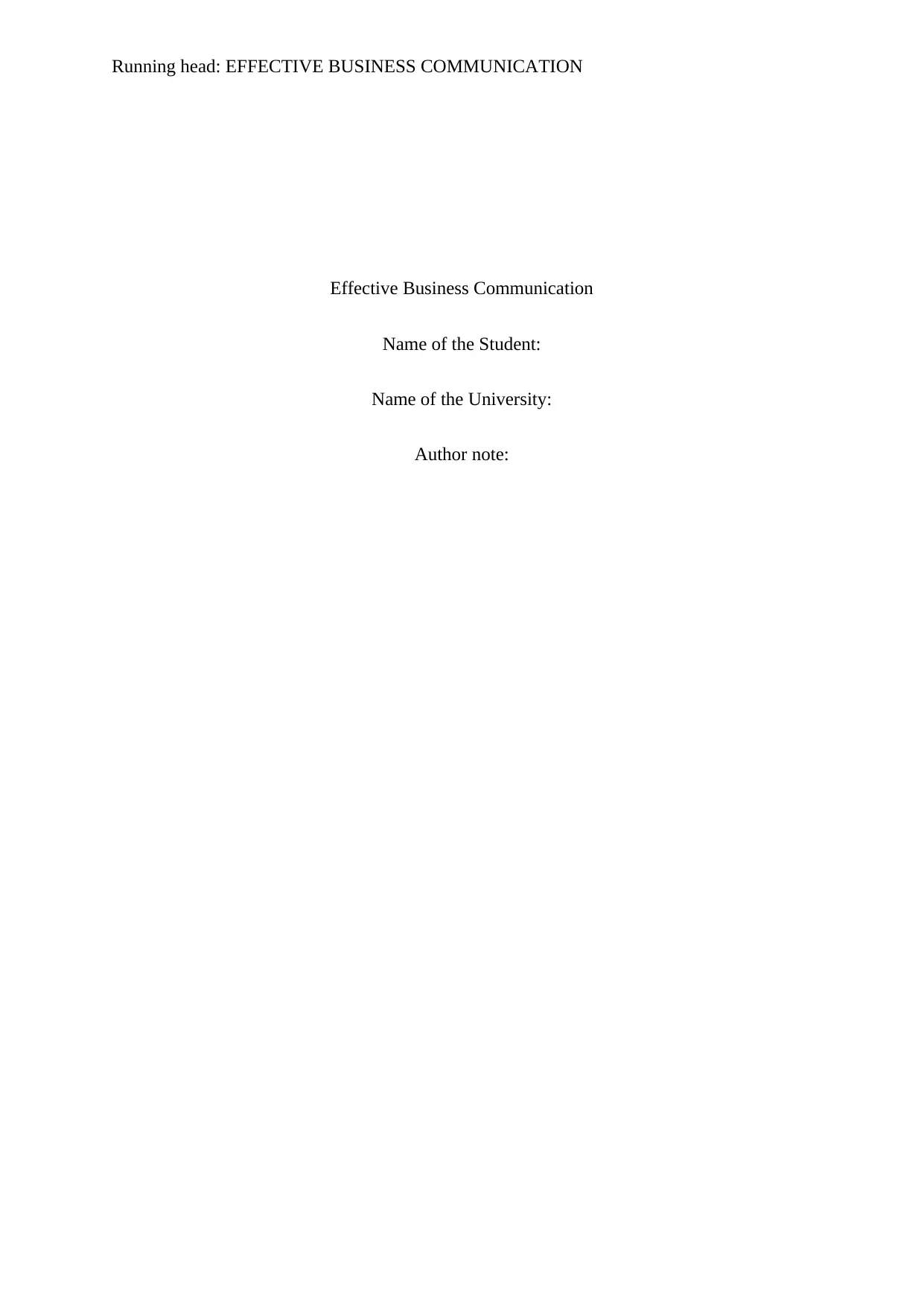
Running head: EFFECTIVE BUSINESS COMMUNICATION
Effective Business Communication
Name of the Student:
Name of the University:
Author note:
Effective Business Communication
Name of the Student:
Name of the University:
Author note:
Secure Best Marks with AI Grader
Need help grading? Try our AI Grader for instant feedback on your assignments.
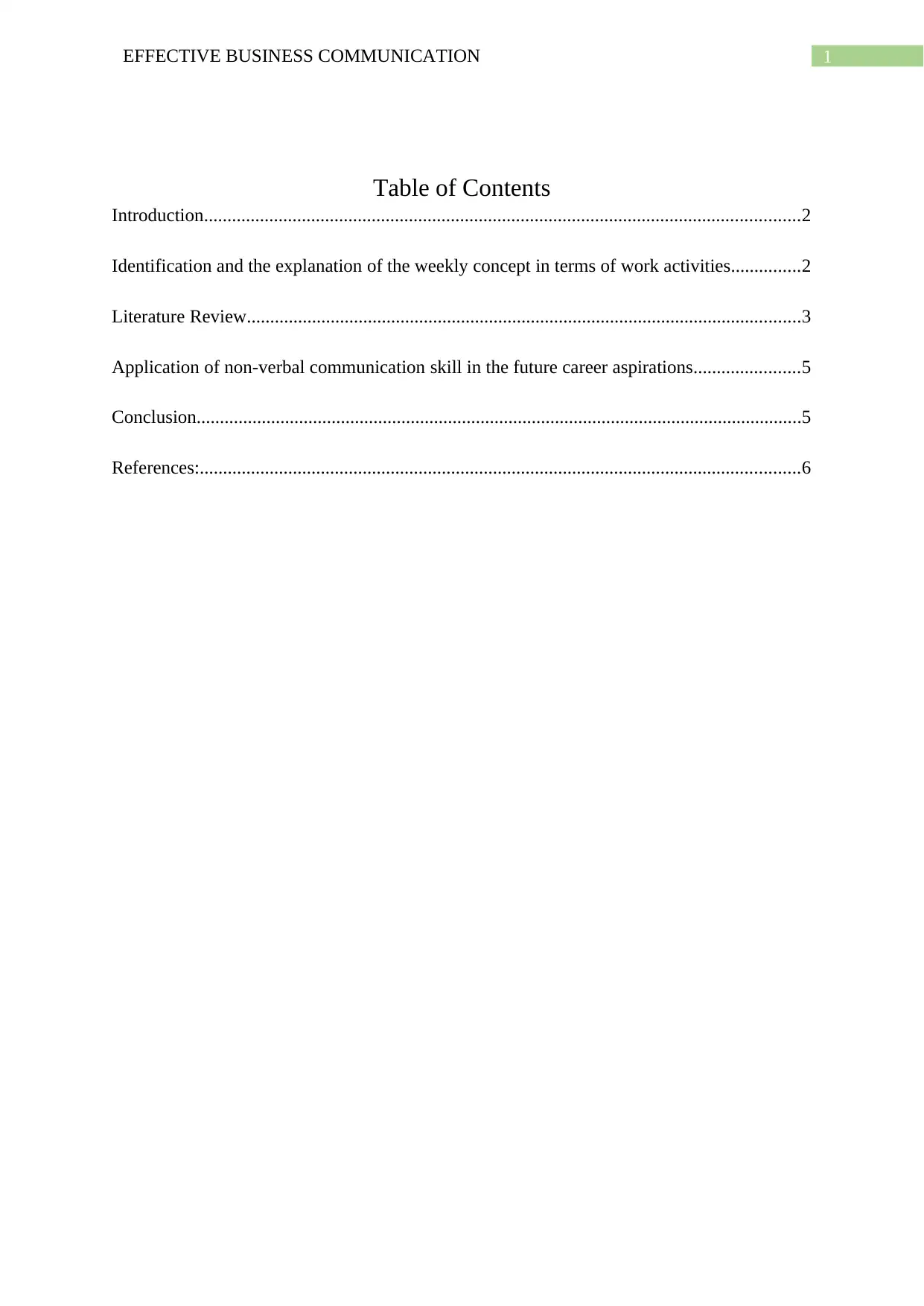
1EFFECTIVE BUSINESS COMMUNICATION
Table of Contents
Introduction................................................................................................................................2
Identification and the explanation of the weekly concept in terms of work activities...............2
Literature Review.......................................................................................................................3
Application of non-verbal communication skill in the future career aspirations.......................5
Conclusion..................................................................................................................................5
References:.................................................................................................................................6
Table of Contents
Introduction................................................................................................................................2
Identification and the explanation of the weekly concept in terms of work activities...............2
Literature Review.......................................................................................................................3
Application of non-verbal communication skill in the future career aspirations.......................5
Conclusion..................................................................................................................................5
References:.................................................................................................................................6
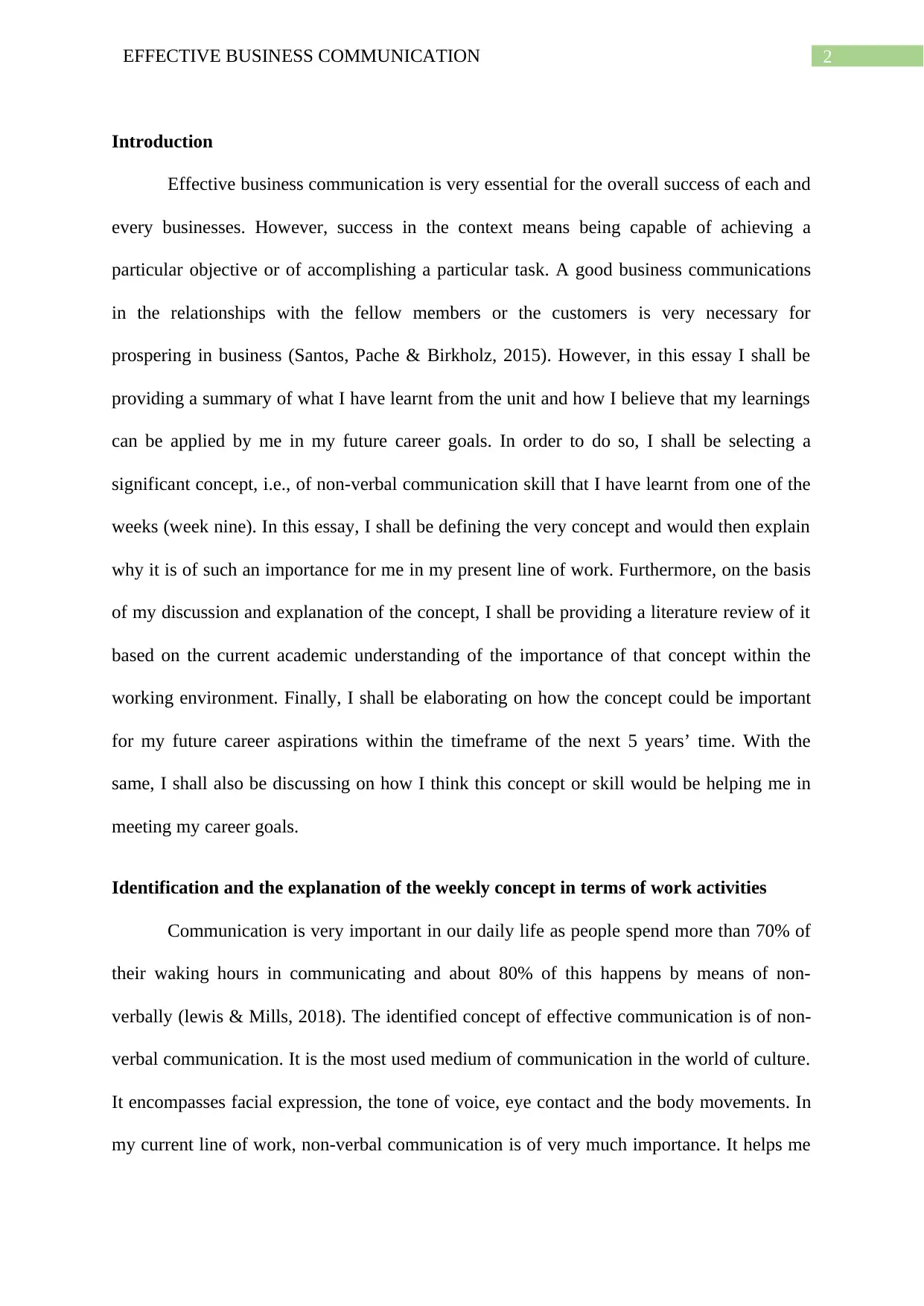
2EFFECTIVE BUSINESS COMMUNICATION
Introduction
Effective business communication is very essential for the overall success of each and
every businesses. However, success in the context means being capable of achieving a
particular objective or of accomplishing a particular task. A good business communications
in the relationships with the fellow members or the customers is very necessary for
prospering in business (Santos, Pache & Birkholz, 2015). However, in this essay I shall be
providing a summary of what I have learnt from the unit and how I believe that my learnings
can be applied by me in my future career goals. In order to do so, I shall be selecting a
significant concept, i.e., of non-verbal communication skill that I have learnt from one of the
weeks (week nine). In this essay, I shall be defining the very concept and would then explain
why it is of such an importance for me in my present line of work. Furthermore, on the basis
of my discussion and explanation of the concept, I shall be providing a literature review of it
based on the current academic understanding of the importance of that concept within the
working environment. Finally, I shall be elaborating on how the concept could be important
for my future career aspirations within the timeframe of the next 5 years’ time. With the
same, I shall also be discussing on how I think this concept or skill would be helping me in
meeting my career goals.
Identification and the explanation of the weekly concept in terms of work activities
Communication is very important in our daily life as people spend more than 70% of
their waking hours in communicating and about 80% of this happens by means of non-
verbally (lewis & Mills, 2018). The identified concept of effective communication is of non-
verbal communication. It is the most used medium of communication in the world of culture.
It encompasses facial expression, the tone of voice, eye contact and the body movements. In
my current line of work, non-verbal communication is of very much importance. It helps me
Introduction
Effective business communication is very essential for the overall success of each and
every businesses. However, success in the context means being capable of achieving a
particular objective or of accomplishing a particular task. A good business communications
in the relationships with the fellow members or the customers is very necessary for
prospering in business (Santos, Pache & Birkholz, 2015). However, in this essay I shall be
providing a summary of what I have learnt from the unit and how I believe that my learnings
can be applied by me in my future career goals. In order to do so, I shall be selecting a
significant concept, i.e., of non-verbal communication skill that I have learnt from one of the
weeks (week nine). In this essay, I shall be defining the very concept and would then explain
why it is of such an importance for me in my present line of work. Furthermore, on the basis
of my discussion and explanation of the concept, I shall be providing a literature review of it
based on the current academic understanding of the importance of that concept within the
working environment. Finally, I shall be elaborating on how the concept could be important
for my future career aspirations within the timeframe of the next 5 years’ time. With the
same, I shall also be discussing on how I think this concept or skill would be helping me in
meeting my career goals.
Identification and the explanation of the weekly concept in terms of work activities
Communication is very important in our daily life as people spend more than 70% of
their waking hours in communicating and about 80% of this happens by means of non-
verbally (lewis & Mills, 2018). The identified concept of effective communication is of non-
verbal communication. It is the most used medium of communication in the world of culture.
It encompasses facial expression, the tone of voice, eye contact and the body movements. In
my current line of work, non-verbal communication is of very much importance. It helps me
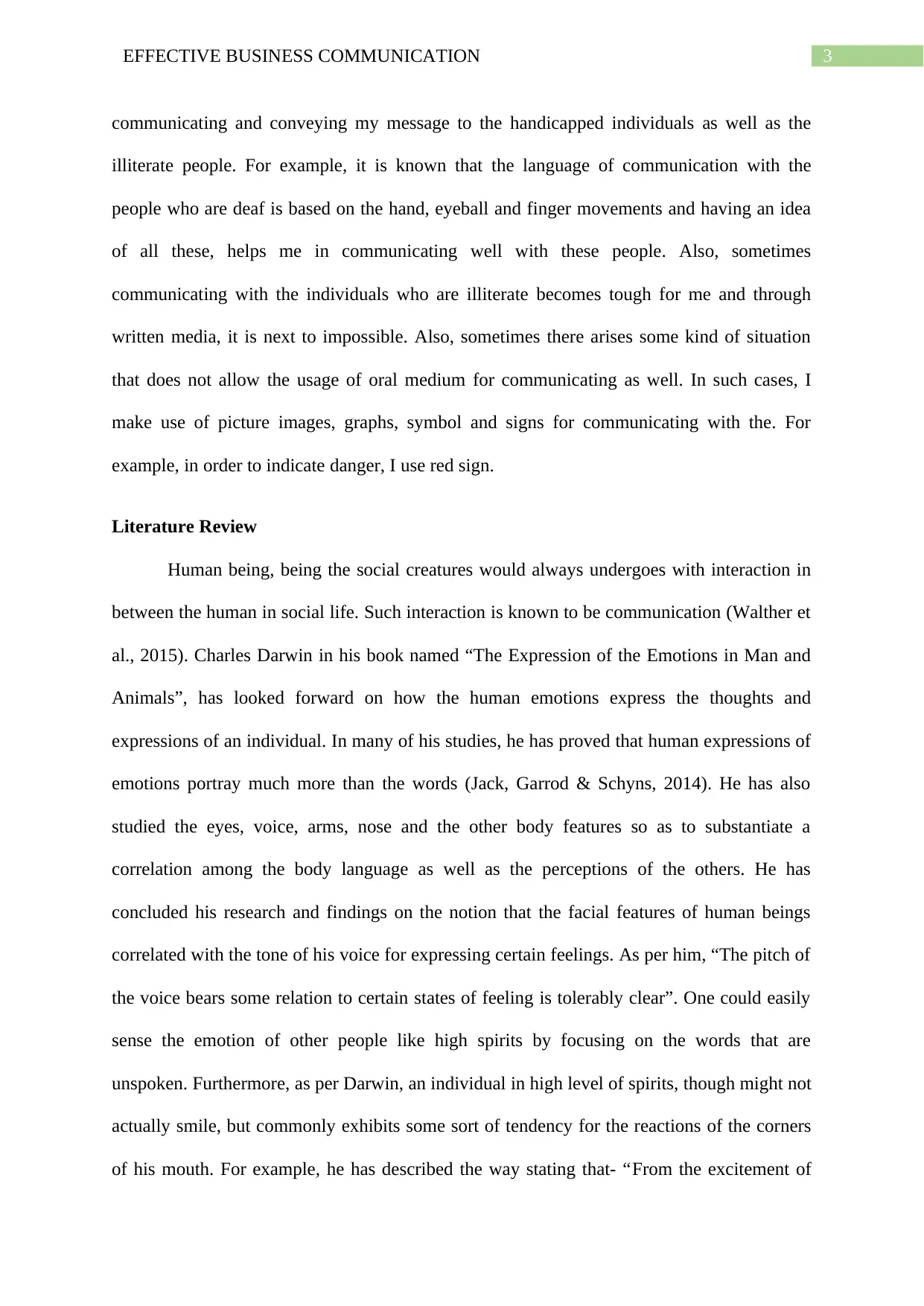
3EFFECTIVE BUSINESS COMMUNICATION
communicating and conveying my message to the handicapped individuals as well as the
illiterate people. For example, it is known that the language of communication with the
people who are deaf is based on the hand, eyeball and finger movements and having an idea
of all these, helps me in communicating well with these people. Also, sometimes
communicating with the individuals who are illiterate becomes tough for me and through
written media, it is next to impossible. Also, sometimes there arises some kind of situation
that does not allow the usage of oral medium for communicating as well. In such cases, I
make use of picture images, graphs, symbol and signs for communicating with the. For
example, in order to indicate danger, I use red sign.
Literature Review
Human being, being the social creatures would always undergoes with interaction in
between the human in social life. Such interaction is known to be communication (Walther et
al., 2015). Charles Darwin in his book named “The Expression of the Emotions in Man and
Animals”, has looked forward on how the human emotions express the thoughts and
expressions of an individual. In many of his studies, he has proved that human expressions of
emotions portray much more than the words (Jack, Garrod & Schyns, 2014). He has also
studied the eyes, voice, arms, nose and the other body features so as to substantiate a
correlation among the body language as well as the perceptions of the others. He has
concluded his research and findings on the notion that the facial features of human beings
correlated with the tone of his voice for expressing certain feelings. As per him, “The pitch of
the voice bears some relation to certain states of feeling is tolerably clear”. One could easily
sense the emotion of other people like high spirits by focusing on the words that are
unspoken. Furthermore, as per Darwin, an individual in high level of spirits, though might not
actually smile, but commonly exhibits some sort of tendency for the reactions of the corners
of his mouth. For example, he has described the way stating that- “From the excitement of
communicating and conveying my message to the handicapped individuals as well as the
illiterate people. For example, it is known that the language of communication with the
people who are deaf is based on the hand, eyeball and finger movements and having an idea
of all these, helps me in communicating well with these people. Also, sometimes
communicating with the individuals who are illiterate becomes tough for me and through
written media, it is next to impossible. Also, sometimes there arises some kind of situation
that does not allow the usage of oral medium for communicating as well. In such cases, I
make use of picture images, graphs, symbol and signs for communicating with the. For
example, in order to indicate danger, I use red sign.
Literature Review
Human being, being the social creatures would always undergoes with interaction in
between the human in social life. Such interaction is known to be communication (Walther et
al., 2015). Charles Darwin in his book named “The Expression of the Emotions in Man and
Animals”, has looked forward on how the human emotions express the thoughts and
expressions of an individual. In many of his studies, he has proved that human expressions of
emotions portray much more than the words (Jack, Garrod & Schyns, 2014). He has also
studied the eyes, voice, arms, nose and the other body features so as to substantiate a
correlation among the body language as well as the perceptions of the others. He has
concluded his research and findings on the notion that the facial features of human beings
correlated with the tone of his voice for expressing certain feelings. As per him, “The pitch of
the voice bears some relation to certain states of feeling is tolerably clear”. One could easily
sense the emotion of other people like high spirits by focusing on the words that are
unspoken. Furthermore, as per Darwin, an individual in high level of spirits, though might not
actually smile, but commonly exhibits some sort of tendency for the reactions of the corners
of his mouth. For example, he has described the way stating that- “From the excitement of
Secure Best Marks with AI Grader
Need help grading? Try our AI Grader for instant feedback on your assignments.
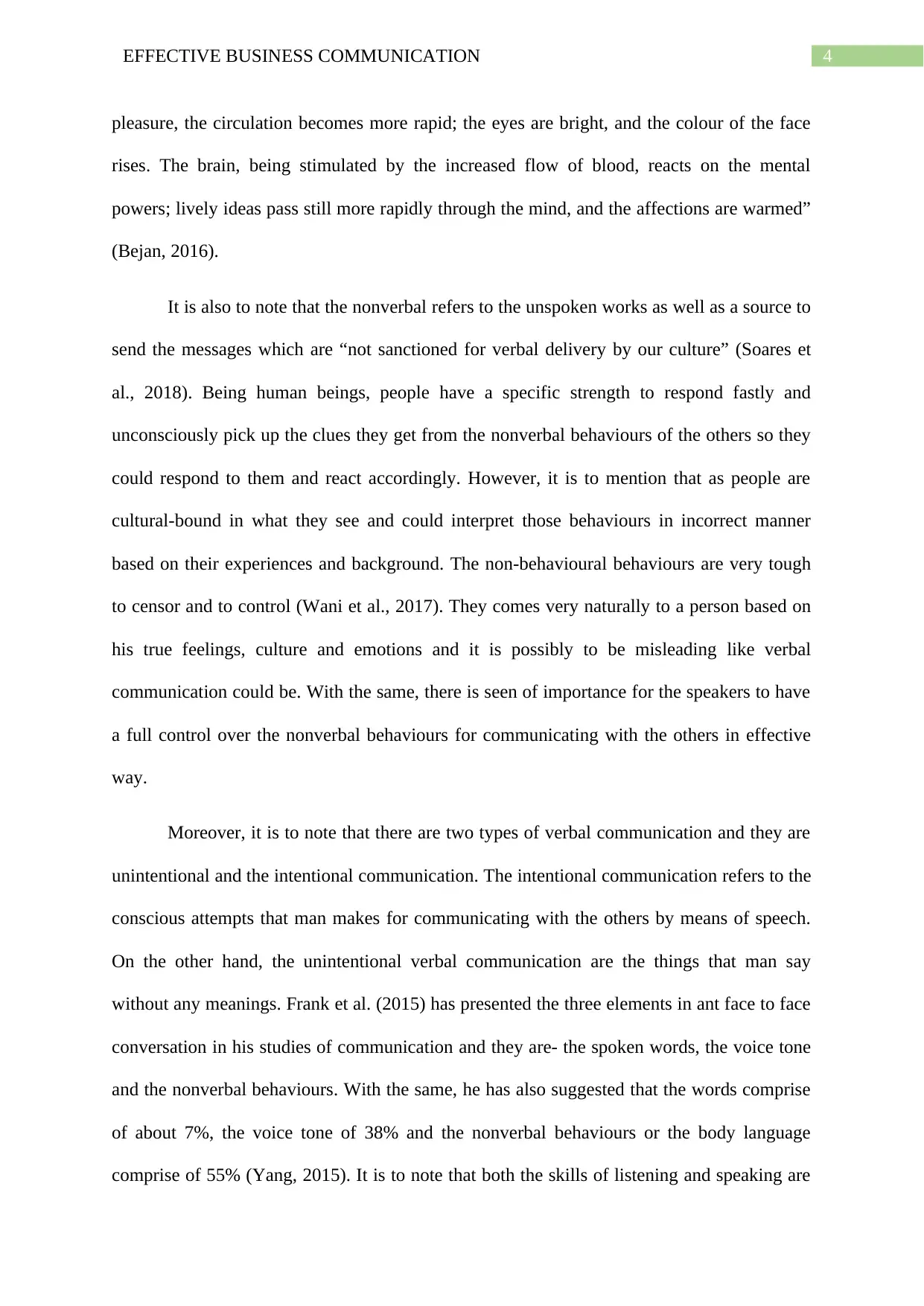
4EFFECTIVE BUSINESS COMMUNICATION
pleasure, the circulation becomes more rapid; the eyes are bright, and the colour of the face
rises. The brain, being stimulated by the increased flow of blood, reacts on the mental
powers; lively ideas pass still more rapidly through the mind, and the affections are warmed”
(Bejan, 2016).
It is also to note that the nonverbal refers to the unspoken works as well as a source to
send the messages which are “not sanctioned for verbal delivery by our culture” (Soares et
al., 2018). Being human beings, people have a specific strength to respond fastly and
unconsciously pick up the clues they get from the nonverbal behaviours of the others so they
could respond to them and react accordingly. However, it is to mention that as people are
cultural-bound in what they see and could interpret those behaviours in incorrect manner
based on their experiences and background. The non-behavioural behaviours are very tough
to censor and to control (Wani et al., 2017). They comes very naturally to a person based on
his true feelings, culture and emotions and it is possibly to be misleading like verbal
communication could be. With the same, there is seen of importance for the speakers to have
a full control over the nonverbal behaviours for communicating with the others in effective
way.
Moreover, it is to note that there are two types of verbal communication and they are
unintentional and the intentional communication. The intentional communication refers to the
conscious attempts that man makes for communicating with the others by means of speech.
On the other hand, the unintentional verbal communication are the things that man say
without any meanings. Frank et al. (2015) has presented the three elements in ant face to face
conversation in his studies of communication and they are- the spoken words, the voice tone
and the nonverbal behaviours. With the same, he has also suggested that the words comprise
of about 7%, the voice tone of 38% and the nonverbal behaviours or the body language
comprise of 55% (Yang, 2015). It is to note that both the skills of listening and speaking are
pleasure, the circulation becomes more rapid; the eyes are bright, and the colour of the face
rises. The brain, being stimulated by the increased flow of blood, reacts on the mental
powers; lively ideas pass still more rapidly through the mind, and the affections are warmed”
(Bejan, 2016).
It is also to note that the nonverbal refers to the unspoken works as well as a source to
send the messages which are “not sanctioned for verbal delivery by our culture” (Soares et
al., 2018). Being human beings, people have a specific strength to respond fastly and
unconsciously pick up the clues they get from the nonverbal behaviours of the others so they
could respond to them and react accordingly. However, it is to mention that as people are
cultural-bound in what they see and could interpret those behaviours in incorrect manner
based on their experiences and background. The non-behavioural behaviours are very tough
to censor and to control (Wani et al., 2017). They comes very naturally to a person based on
his true feelings, culture and emotions and it is possibly to be misleading like verbal
communication could be. With the same, there is seen of importance for the speakers to have
a full control over the nonverbal behaviours for communicating with the others in effective
way.
Moreover, it is to note that there are two types of verbal communication and they are
unintentional and the intentional communication. The intentional communication refers to the
conscious attempts that man makes for communicating with the others by means of speech.
On the other hand, the unintentional verbal communication are the things that man say
without any meanings. Frank et al. (2015) has presented the three elements in ant face to face
conversation in his studies of communication and they are- the spoken words, the voice tone
and the nonverbal behaviours. With the same, he has also suggested that the words comprise
of about 7%, the voice tone of 38% and the nonverbal behaviours or the body language
comprise of 55% (Yang, 2015). It is to note that both the skills of listening and speaking are
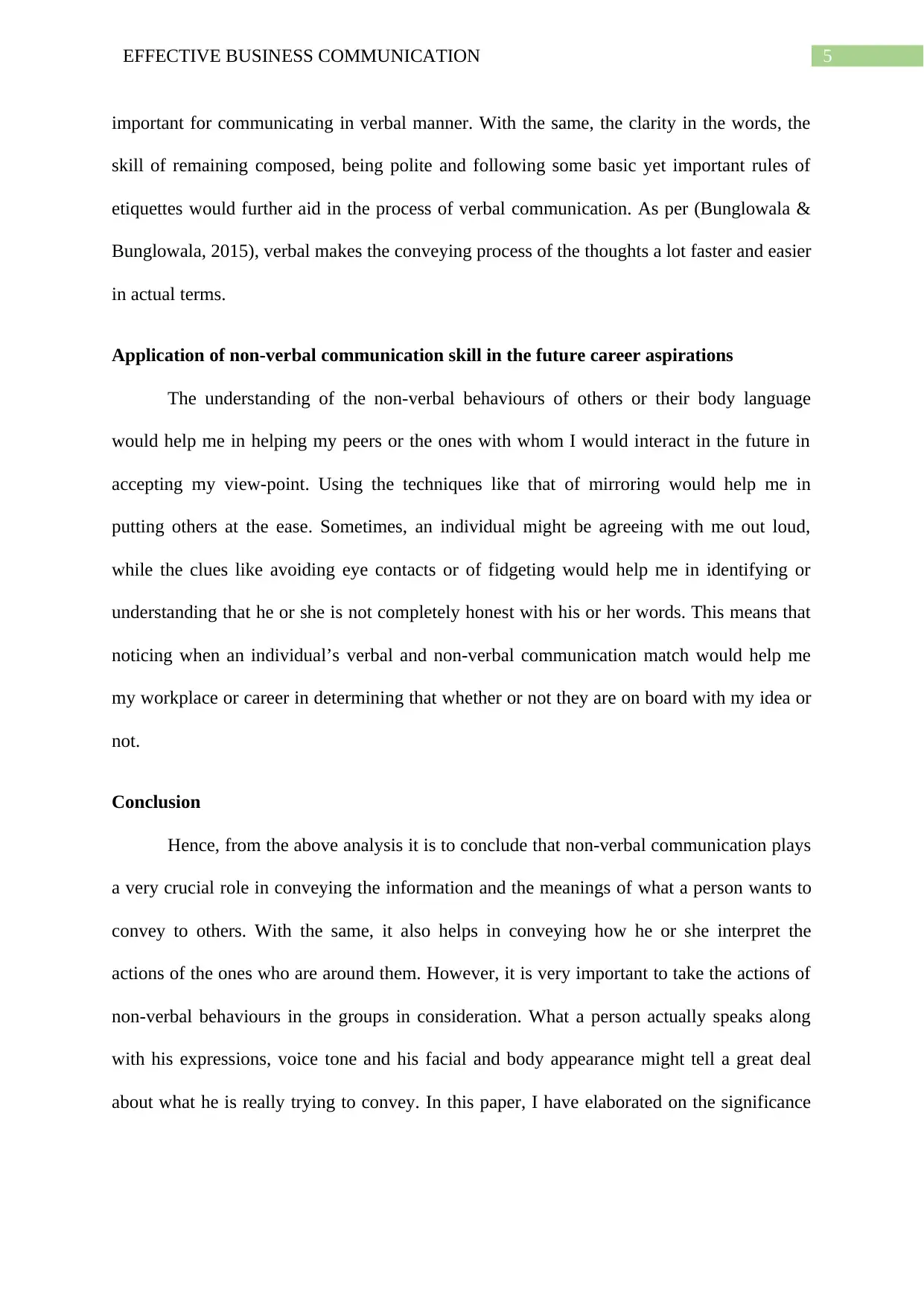
5EFFECTIVE BUSINESS COMMUNICATION
important for communicating in verbal manner. With the same, the clarity in the words, the
skill of remaining composed, being polite and following some basic yet important rules of
etiquettes would further aid in the process of verbal communication. As per (Bunglowala &
Bunglowala, 2015), verbal makes the conveying process of the thoughts a lot faster and easier
in actual terms.
Application of non-verbal communication skill in the future career aspirations
The understanding of the non-verbal behaviours of others or their body language
would help me in helping my peers or the ones with whom I would interact in the future in
accepting my view-point. Using the techniques like that of mirroring would help me in
putting others at the ease. Sometimes, an individual might be agreeing with me out loud,
while the clues like avoiding eye contacts or of fidgeting would help me in identifying or
understanding that he or she is not completely honest with his or her words. This means that
noticing when an individual’s verbal and non-verbal communication match would help me
my workplace or career in determining that whether or not they are on board with my idea or
not.
Conclusion
Hence, from the above analysis it is to conclude that non-verbal communication plays
a very crucial role in conveying the information and the meanings of what a person wants to
convey to others. With the same, it also helps in conveying how he or she interpret the
actions of the ones who are around them. However, it is very important to take the actions of
non-verbal behaviours in the groups in consideration. What a person actually speaks along
with his expressions, voice tone and his facial and body appearance might tell a great deal
about what he is really trying to convey. In this paper, I have elaborated on the significance
important for communicating in verbal manner. With the same, the clarity in the words, the
skill of remaining composed, being polite and following some basic yet important rules of
etiquettes would further aid in the process of verbal communication. As per (Bunglowala &
Bunglowala, 2015), verbal makes the conveying process of the thoughts a lot faster and easier
in actual terms.
Application of non-verbal communication skill in the future career aspirations
The understanding of the non-verbal behaviours of others or their body language
would help me in helping my peers or the ones with whom I would interact in the future in
accepting my view-point. Using the techniques like that of mirroring would help me in
putting others at the ease. Sometimes, an individual might be agreeing with me out loud,
while the clues like avoiding eye contacts or of fidgeting would help me in identifying or
understanding that he or she is not completely honest with his or her words. This means that
noticing when an individual’s verbal and non-verbal communication match would help me
my workplace or career in determining that whether or not they are on board with my idea or
not.
Conclusion
Hence, from the above analysis it is to conclude that non-verbal communication plays
a very crucial role in conveying the information and the meanings of what a person wants to
convey to others. With the same, it also helps in conveying how he or she interpret the
actions of the ones who are around them. However, it is very important to take the actions of
non-verbal behaviours in the groups in consideration. What a person actually speaks along
with his expressions, voice tone and his facial and body appearance might tell a great deal
about what he is really trying to convey. In this paper, I have elaborated on the significance
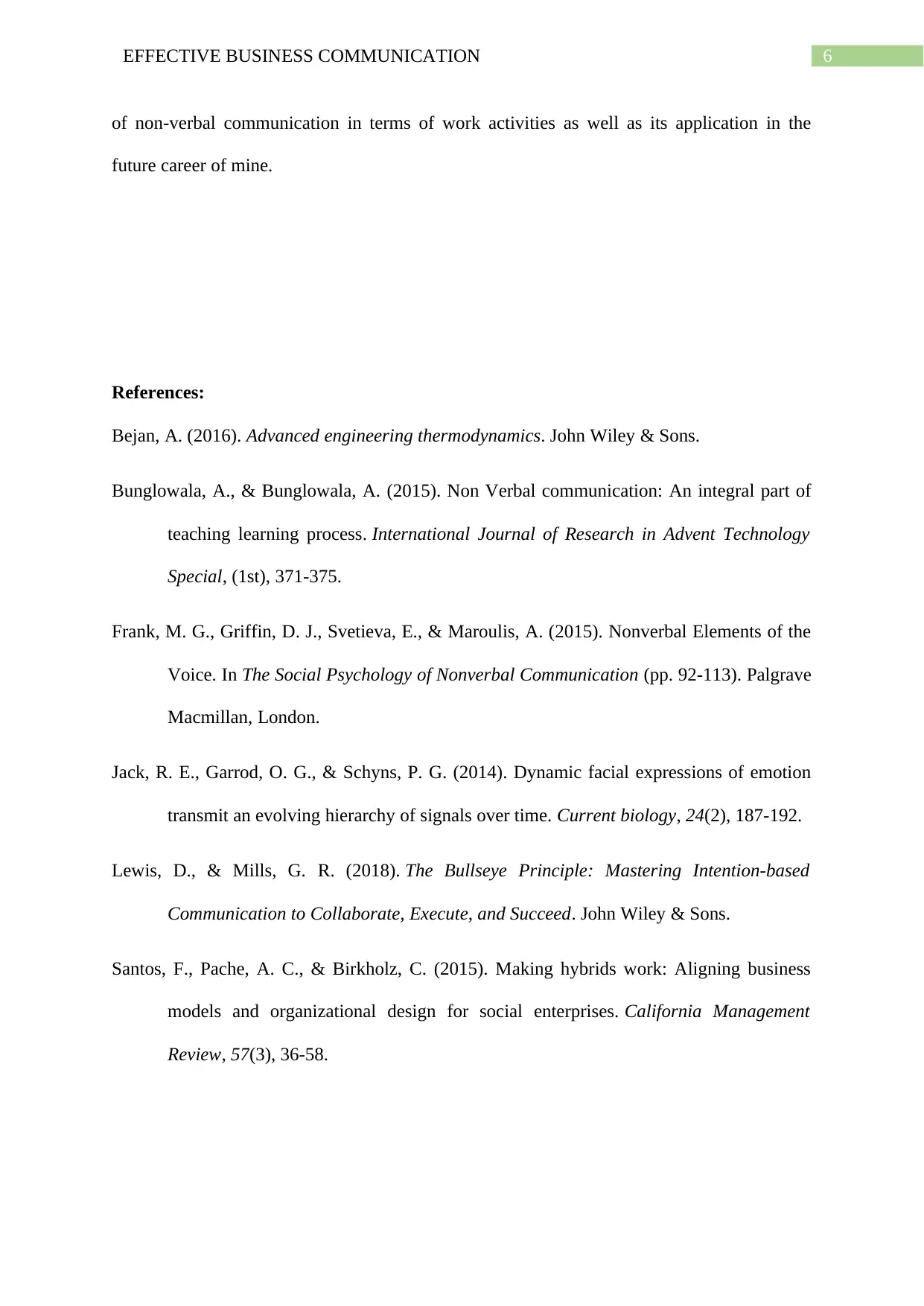
6EFFECTIVE BUSINESS COMMUNICATION
of non-verbal communication in terms of work activities as well as its application in the
future career of mine.
References:
Bejan, A. (2016). Advanced engineering thermodynamics. John Wiley & Sons.
Bunglowala, A., & Bunglowala, A. (2015). Non Verbal communication: An integral part of
teaching learning process. International Journal of Research in Advent Technology
Special, (1st), 371-375.
Frank, M. G., Griffin, D. J., Svetieva, E., & Maroulis, A. (2015). Nonverbal Elements of the
Voice. In The Social Psychology of Nonverbal Communication (pp. 92-113). Palgrave
Macmillan, London.
Jack, R. E., Garrod, O. G., & Schyns, P. G. (2014). Dynamic facial expressions of emotion
transmit an evolving hierarchy of signals over time. Current biology, 24(2), 187-192.
Lewis, D., & Mills, G. R. (2018). The Bullseye Principle: Mastering Intention-based
Communication to Collaborate, Execute, and Succeed. John Wiley & Sons.
Santos, F., Pache, A. C., & Birkholz, C. (2015). Making hybrids work: Aligning business
models and organizational design for social enterprises. California Management
Review, 57(3), 36-58.
of non-verbal communication in terms of work activities as well as its application in the
future career of mine.
References:
Bejan, A. (2016). Advanced engineering thermodynamics. John Wiley & Sons.
Bunglowala, A., & Bunglowala, A. (2015). Non Verbal communication: An integral part of
teaching learning process. International Journal of Research in Advent Technology
Special, (1st), 371-375.
Frank, M. G., Griffin, D. J., Svetieva, E., & Maroulis, A. (2015). Nonverbal Elements of the
Voice. In The Social Psychology of Nonverbal Communication (pp. 92-113). Palgrave
Macmillan, London.
Jack, R. E., Garrod, O. G., & Schyns, P. G. (2014). Dynamic facial expressions of emotion
transmit an evolving hierarchy of signals over time. Current biology, 24(2), 187-192.
Lewis, D., & Mills, G. R. (2018). The Bullseye Principle: Mastering Intention-based
Communication to Collaborate, Execute, and Succeed. John Wiley & Sons.
Santos, F., Pache, A. C., & Birkholz, C. (2015). Making hybrids work: Aligning business
models and organizational design for social enterprises. California Management
Review, 57(3), 36-58.
Paraphrase This Document
Need a fresh take? Get an instant paraphrase of this document with our AI Paraphraser

7EFFECTIVE BUSINESS COMMUNICATION
Soares, P. F., Rocha, A. P. M., Guimarães, T. M., Leite, F. L., Andery, M. A. P., & Tourinho,
E. Z. (2018). Effects of verbal and non-verbal cultural consequences on
culturants. Behavior and Social Issues, 27, 31-46.
Walther, S., Stegmayer, K., Sulzbacher, J., Vanbellingen, T., Müri, R., Strik, W., &
Bohlhalter, S. (2015). Nonverbal social communication and gesture control in
schizophrenia. Schizophrenia bulletin, 41(2), 338-345.
Wani, O., Scheidegger, A., Carbajal, J. P., Rieckermann, J., & Blumensaat, F. (2017).
Parameter estimation of hydrologic models using a likelihood function for censored
and binary observations. Water research, 121, 290-301.
Yang, P. (2015). Intercultural nonverbal communication competence: meeting body language
challenges in facilitating and working with students from culturally diverse
backgrounds in the Australian higher education context. Journal of Communications
Research, 7(1).
Soares, P. F., Rocha, A. P. M., Guimarães, T. M., Leite, F. L., Andery, M. A. P., & Tourinho,
E. Z. (2018). Effects of verbal and non-verbal cultural consequences on
culturants. Behavior and Social Issues, 27, 31-46.
Walther, S., Stegmayer, K., Sulzbacher, J., Vanbellingen, T., Müri, R., Strik, W., &
Bohlhalter, S. (2015). Nonverbal social communication and gesture control in
schizophrenia. Schizophrenia bulletin, 41(2), 338-345.
Wani, O., Scheidegger, A., Carbajal, J. P., Rieckermann, J., & Blumensaat, F. (2017).
Parameter estimation of hydrologic models using a likelihood function for censored
and binary observations. Water research, 121, 290-301.
Yang, P. (2015). Intercultural nonverbal communication competence: meeting body language
challenges in facilitating and working with students from culturally diverse
backgrounds in the Australian higher education context. Journal of Communications
Research, 7(1).
1 out of 8
Related Documents
Your All-in-One AI-Powered Toolkit for Academic Success.
+13062052269
info@desklib.com
Available 24*7 on WhatsApp / Email
![[object Object]](/_next/static/media/star-bottom.7253800d.svg)
Unlock your academic potential
© 2024 | Zucol Services PVT LTD | All rights reserved.



